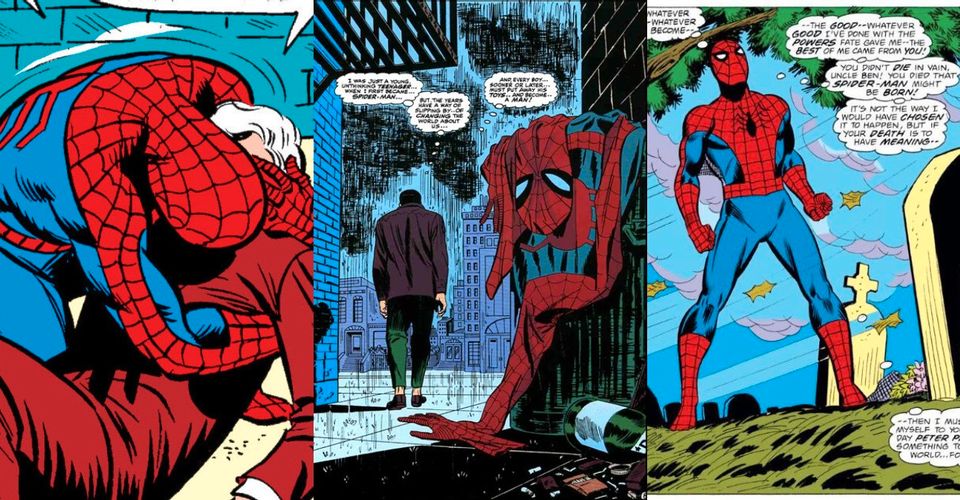11 Most Iconic Spider-Man Marvel Comic Book Panels

Marvel’s most prized property Spider-Man is the most popular individual superhero IP in the world, with only Batman coming close. The character has long since proven his status as a cultural phenomenon, with Sam Raimi’s movies beginning in the early 2000s bolstering that popularity.
Though, as any legacy superhero should, the wall-crawler leaves a trail of memorable comic book stories that illustrate some equally memorable panels. Many of these iconic artworks emphasize key moments in the character’s vast mythos — dating as far back as Spider-Man’s inception in 1962’s Amazing Fantasy #15 — that would shape how millions of fans would perceive the character in every medium he appears in.
Updated on March 25th by Guillermo Kurten: The best Spider-Man comic book panels have inspired some of the most famous moments in the Spider-Man movies, from the Sam Raimi era to Tom Holland in the MCU. With the digital release of No Way Home, now is a great time to look at some more of the most iconic Spider-Man panels.
Spider-Man No More! (The Amazing Spider-Man)

Perhaps one of the most resonant panels in the hero’s comics is when he initially retires the mantle of the superhero. The Spider-Man No More! arc was written by Stan Lee — one of Spider-Man’s best writers — centers around Peter Parker dealing with a grueling amount of pressure thrown onto his shoulders as both identities. J. Johan Jameson’s smear campaign on the wall-crawler is dealing increasing amounts of damage on his reputation, as a bystander of a bank robbery the hero stopped is terrified of him.
Then, he finds out through Harry Osborn that his Aunt May has fallen sick, and Peter’s grades begin to drop as a result. The young man begins to sour on the idea of Spider-Man and dumps his suit in the trash. It’s a somber, powerful, and classic panel that Raimi even used for one of his movies. Understandably so since this is arguably one of the first images to come to fans’ minds when thinking about the character’s comic book legacy.
The Symbiote Suit (Secret Wars)

Another memorable moment in the character’s history is the introduction of the symbiote and the resulting black suit that was created. The original symbiote to be used was Venom, arguably the most popular one. It attached itself to Peter’s traditional red and blue suit during the Secret Wars story arc/miniseries. It’s an “origin” within this superhero’s mythos that remained constant during Spider-Man’s world and comics experiencing changes over the decades.
Eventually, Peter does manage to resist and reject the symbiote once he finally realizes the sinister nature of the extraterrestrial organism, and then it latches itself onto its most popular host Eddie Brock. The symbiotes, including Venom and Carnage, are some of the most well-known characters in the Spider-Man corner of the universe, making the former’s first visit to Peter a milestone in Marvel comics’ lore.
Gwen’s Death (The Night Gwen Stacy Died)

Gwen Stacy was the first love interest in Peter Parker’s life, and her demise in The Night Gwen Stacy Died was one of the most heart-breaking moments in comics. The Green Goblin kidnaps Gwen to lure Spider-Man to the George Washington Bridge, leading to the villain throwing her off. Spider-Man thinks he saves her by catching Gwen with his webs, only to discover that she was already dead.
The immense sense of guilt overcomes him as he can’t figure out whether her neck was broken due to Spider-Man’s webs causing whiplash, or if Goblin did it beforehand. The dialogue gradually showing him go from immense relief to sorrow at his realization is an incredibly dark and emotional succession of panels. It’s a haunting moment similar to the death of Jason Todd for Batman in A Death in the Family. A massive turning point in the hero’s life that the protagonist regards as their greatest failure, haunting them in some capacity throughout their career.
A Death That Deserves Meaning (The Amazing Spider-Man)

A brief one-off story during The Amazing Spider-Man sees the titular character visit Uncle Ben’s grave and reflect on the troubles of his past — and the supervillains that caused them. He recalls his origins including the death of his Uncle Ben, the deaths of the Stacys, Harry’s dark descent that turned him into the second Green Goblin, J.J.’s Spidey smear campaign, and more. However, on a brighter note, Spider-Man also reflects on his best relationships like the Fantastic Four, Daredevil, and his new love interest Mary Jane Watson.
He looks on as he sees Aunt May pay his respects, and after she leaves, he does the same and leaves the microscope Ben gave Peter as a child. The panel with him standing in front of Ben’s grave is another classic example of a well-illustrated somber moment that emphasizes Spider-Man’s mourning, and a reminder to him and readers of why he does what he does. It’s also an issue that demonstrates how to execute a good “bittersweet” story.
Peter’s First Lesson (Amazing Fantasy)

The cover art by Jack Kirby for Stan Lee and Steve Ditko’s debut of Spider-Man in Amazing Fantasy #15 is a comic book icon as is, but his story and a key panel inside also help set the storytelling precedent for the superhero from thereon. By the latter end of this intro story, Peter Parker’s alter ego gains celebrity status, which proves to get to his head. Peter lets a thief that a guard was chasing escape, exclaiming that it’s not his job, and refuses to let anybody push him around.
Later, Peter discovers that Uncle Ben was killed by a burglar that turned out to be the very same one he refused to catch. When Spider-Man apprehends this man is the moment he realizes his grave mistake, and thus learns his first and most vital lesson. “With great power comes great responsibility.” Using his powers for vanity is an abuse of the capabilities he can put to use for the greater good and does no favors for those close to him either. A brilliant lesson in compassion and empathy, and also well adapted in 2002’s Spider-Man.
Buried Alive (Kraven’s Last Hunt)

It’s undoubtedly one of Spider-Man’s darkest comic book stories, and fitting since this heavy blow was inflicted on him by one of his most ruthless villains. Kraven’s Last Hunt sees the titular supervillain enact his most relentless attack on the wall-crawler to finally prove himself as the world’s apex predator. The vicious Kraven nearly kills the hero and caps off his victory over him by burying him alive. Afterward, he does on to take on the Spider-Man mantle to be one of the most unhinged iterations of the character put to paper.
The quick and straightforward progression of panels gradually closing in on Kraven’s face suddenly bursting into maniacal laughter, all while in the black suit, is one of the most haunting pieces of imagery in comics given everything that happened. This dark tale understandably stands as one of the greatest comic book arcs of all time, let alone Spider-Man’s.
When The Going Gets Tough (The Amazing Spider-Man)

The Amazing Spider-Man brings forth a panel and culminating story that earned its place as one of the triumphant moments in the medium. Aunt May is in danger and Peter needs to get a cure for her quickly but is trapped under a punishing amount of rubble, even with all his enhanced strength.
Desperate to save her life, he manages to push himself — both physically and mentally — to do what needs to be done even in the face of a harrowing obstacle. Mustering all the power he has in his body, emphasized by the excellent transitions illustrated by Ditko and dialogue by Lee combine for an emphatically inspirational scene that will stand the test of time. The panels were also paid homage to in the MCU’s Spider-Man: Homecoming and, most importantly, felt earned in doing so.
“…But It’s Not Just Me” (Truth/Dare)

Though it didn’t come in the pages of Spider-Man’s comic book series, Chip Zdarsky’s current and acclaimed Daredevil run includes the Wall-Crawler in some satisfying guest roles to the Man Without Fear. This run opens with Daredevil having to face a crisis of identity and purpose, grappling with the realization that he accidentally killed a thief due to being physically out of form.
The two heroes have an initially tense dynamic, with Spider-Man warning Murdock of taking the mantle back up. However, after a grand comeback and renewed sense of purpose, Daredevil returns with Spidey in support, breaking into the Hell’s Kitchen crime families’ hideout to fire a warning. Marco Checchetto’s artwork speaks for itself, with this panel using excellent lighting and shadows to give both heroes an imposing entrance and a taste for the duo’s iconic Marvel friendship.
Tryouts (The Amazing Spider-Man)

The first issue of The Amazing Spider-Man — written by Stan Lee and illustrated by Steve Ditko — was more than just a landmark for the start of the series, but also the first time Marvel Comics acknowledged their shared comic book universe by crossing the titular hero with the Fantastic Four.
It’s also the first appearance of the infamous James Jonah Jameson, with the superhero eventually breaking into the Fantastic Four’s headquarters to convince Reed Richards and co. to hire him. The encounter was brief, but the scene and the comic’s cover/panel hybrid is an iconic piece of comic book history.
The Wedding! (The Amazing Spider-Man)

Undoubtedly one of the most impactful things to happen to Peter Parker was his wedding to Mary Jane Watson, written and illustrated by Jim Shooter and David Michelinie in a similarly-named storyline. Spider-Man is one of the Marvel superheroes infamous for having such a hard time finding long-lasting peace in his life, which is what makes this story and panel so heartfelt and memorable.
Gwen Stacy’s death was one of the darkest deaths in comics, with Peter carrying that weight for years. It makes this moment even more important that he was able to move on to the stage of his life and find love again with Mary Jane. John Romita Sr.’s cover art here is a perfect encapsulation of ’80s comic art as well.
Origin Story (Amazing Fantasy)

The concept of origin stories in the superhero genre might feel like a relic of the past now, but they still serve as fantastic and nostalgic pieces of history for beloved characters. Few characters aside from Spider-Man (i.e. Batman, Superman, etc.) have their origins so ingrained into common pop culture knowledge, and Stan Lee’s origins for the Friendly Neighborhood superhero in Amazing Fantasy is another milestone in the medium’s history.
The series, much like DC’s Detective Comics to Batman, was an unrelated anthology series before the superhero debuted and made the comic his own. It was a small moment for that time, but what would spin out would prove to be a comic book dynasty of a character.
About The Author

















